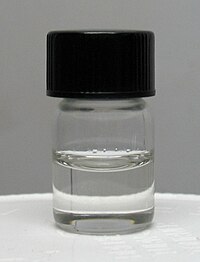Etilendiamin
Etilendiamin je organsko jedinjenje sa formulom C2H4(NH2)2. On je bezbojna tečnost sa mirisom sličnom amonijaku. On je veoma bazan amin. Tečnost formira dim u kontaktu sa vlažnim vazduhom. On je u širokoj primeni kao gradivni blok u hemijskoj sintezi. Oko 500.000.000 kg je proizvedeno 1998.[6]
| |||

| |||
| Nazivi | |||
|---|---|---|---|
| Preferisani IUPAC naziv
1,2-Diaminoetan | |||
| Sistemski IUPAC naziv
Etan-1,2-diamin[2] | |||
| Drugi nazivi
Edamin[1]
| |||
| Identifikacija | |||
3D model (Jmol)
|
|||
| Abrevijacija | en | ||
| Bajlštajn | 605263 | ||
| ChEBI | |||
| ChemSpider | |||
| ECHA InfoCard | 100.003.154 | ||
| EC broj | 203-468-6 | ||
| Gmelin Referenca | 1098 | ||
| KEGG[3] | |||
| MeSH | ethylenediamine | ||
| RTECS | KH8575000 | ||
| UNII | |||
| UN broj | 1604 | ||
| |||
| Svojstva | |||
| C2H8N2 | |||
| Molarna masa | 60,10 g·mol−1 | ||
| Agregatno stanje | bezbojna tečnost | ||
| Miris | poput amonijaka | ||
| Gustina | 899 mg mL−1 | ||
| Tačka topljenja | 28.142 °C; 50.687 °F; 28.415 K | ||
| log P | −2,057 | ||
| Napon pare | 1,3 kPa (na 20 °C) | ||
| kH | 5,8 mol Pa−1 kg−1 | ||
| Indeks refrakcije (nD) | 1,4565 | ||
| Termohemija | |||
| Specifični toplotni kapacitet, C | 172,59 J K−1 mol−1 | ||
| Standardna molarna entropija S |
202,42 J K−1 mol−1 | ||
Std entalpija
formiranja (ΔfH⦵298) |
−63,55–−62,47 kJ mol−1 | ||
| Std entalpija sagorevanja ΔcH |
−1.8678–−1.8668 MJ mol−1 | ||
| Opasnosti | |||
| GHS grafikoni |    
| ||
| GHS signalna reč | Opasnost | ||
| H226, H302, H312, H314, H317, H334 | |||
| P261, P280, P305+351+338, P310 | |||
EU klasifikacija (DSD)
|
|||
| R-oznake | R10, R21/22, R34, R42/43 | ||
| S-oznake | (S1/2), S26, S36/37/39, S45 | ||
| NFPA 704 | |||
| Tačka paljenja | 38 °C | ||
| 380 °C (716 °F; 653 K) | |||
| Eksplozivni limiti | 2,7–16% | ||
| Letalna doza ili koncentracija (LD, LC): | |||
LD50 (LD50)
|
1,2 g kg−1 (oralno, pacov) | ||
| Srodna jedinjenja | |||
Srodne alkanaminske materije
|
|||
Srodna jedinjenja
|
|||
Ukoliko nije drugačije napomenuto, podaci se odnose na standardno stanje materijala (na 25 °C [77 °F], 100 kPa). | |||
| Reference infokutije | |||
Sinteza
уредиEtilendiamin se industrijski proizvodi iz 1,2-dihloroetana i amonijaka pod pritiskom na 180 °C u vodenoj sredini:[6][7]
U ovoj reakciji se formira hlorovodonik, koji formira so sa aminom. Amin se oslobađa adicijom natrijum hidroksida i može se izdvojiti destilacijom. Dietilentriamin (DETA) i trietilentetramin (TETA) se formiraju kao nusproizvodi.
Reference
уреди- ^ „32007R0129”. European Union. 12. 2. 2007. Annex II. Приступљено 3. 5. 2012.
- ^ „ethylenediamine - Compound Summary”. PubChem Compound. USA: National Center for Biotechnology Information. 16. 9. 2004. Identification and Related Records. Приступљено 3. 5. 2012.
- ^ Joanne Wixon; Douglas Kell (2000). „Website Review: The Kyoto Encyclopedia of Genes and Genomes — KEGG”. Yeast. 17 (1): 48—55. doi:10.1002/(SICI)1097-0061(200004)17:1<48::AID-YEA2>3.0.CO;2-H.
- ^ Li Q, Cheng T, Wang Y, Bryant SH (2010). „PubChem as a public resource for drug discovery.”. Drug Discov Today. 15 (23-24): 1052—7. PMID 20970519. doi:10.1016/j.drudis.2010.10.003.
- ^ Evan E. Bolton; Yanli Wang; Paul A. Thiessen; Stephen H. Bryant (2008). „Chapter 12 PubChem: Integrated Platform of Small Molecules and Biological Activities”. Annual Reports in Computational Chemistry. 4: 217—241. doi:10.1016/S1574-1400(08)00012-1.
- ^ Врати се на: а б Karsten Eller, Erhard Henkes, Roland Rossbacher, Hartmut Höke "Amines, Aliphatic" in Ullmann's Encyclopedia of Industrial Chemistry, 2005 Verlag, Weinheim. . Weinheim: Wiley-VCH. doi:10.1002/14356007.a02_001. Недостаје или је празан параметар
|title=(помоћ) - ^ Hans-Jürgen Arpe, Industrielle Organische Chemie, 6. Auflage (2007), Seite 245, Wiley VCH


